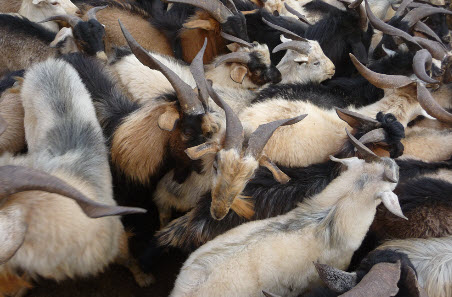Goats go the distance for NSW producers

- Location: 30km east of Bourke, NSW
- Enterprise: Summerville Partnership
- Producers: Lindsay, Rob and Marie Newton
- Property size: approximately 56,656ha
- Soils and grasses: mix of black soil following the water ways and red mulga country
- Rainfall: 330mm
- Goat herd size: 10,000 to 15,000 rangeland goats
- Target market: export carcases and domestic ethnic communities
- Other farm enterprises: none
Why goats?
Rob Newton and his family have been involved in the goat industry for 20 years and are now exclusively focused on goats after transitioning out of sheep and cattle production in 2017.
Recognising the financial and management benefits of goat production, Rob’s father, Lindsay - previously a staunch Merino producer - encouraged the family business to make the move out of sheep and cattle.
While Rob took a bit longer to come around to the idea, the cattle and sheep are now gone from Summerville Station and the goats remain. For Lindsay and Rob, it was the ease of management regarding handling and maintenance of goats that sealed the deal for them; combined with the fact the goats were outperforming the sheep and cattle in terms of financial returns and growth rates, particularly in drier times.
The Newtons have been running a goat depot for a number of years and sell between 150,000 to 200,000 animals each year, mostly to the meat trade. Goats are supplied to the depot from within a 200km radius.
Grazing management and infrastructure
Initially, only the property boundary was fenced for goats, but Rob and Lindsay have been gradually tackling the internal fencing and breaking the paddocks up into smaller, more manageable sizes.
“Our black soil country can carry a higher stocking rate with the clovers and Mitchell grass, so we’ve been aiming for paddocks from 1,000 to 1,600ha in those areas and 2,400 to 4,000ha in the red mulga country,” Rob said.
“We’re looking to better manage the grazing pressure now with these smaller paddocks and we can start separating out the females, males and the young animals we’re looking to grow out.”
Rob keeps a close eye on stocking rates to ensure the goats are not putting too much pressure on the paddocks.
“We use similar stocking rates as for sheep, and when we need to we offload the market ready bucks and unwanted does,” Rob said.
The goat fencing is predominately seven-to-eight line hinge joint. Yards have been altered to ensure they are high enough to keep the goats in and the races filled in so the goats can’t see out of them. This has improved ease of handling.
Breeding and husbandry
The Newtons aim to retain 6,000 to 8,000 breeding rangeland does when seasons permit.
“Our goal is to cross these does with the better rangeland bucks,” Rob said.
“We’re selecting bucks based only on physical appearance at the moment and loosely on the same kinds of characteristics you’d look for in your bulls. We want well-muscled animals with a deep chest, good frame and short hair. The shorter hair is important for our buyers as the goats are mostly sold skin-on and the shorter hair is easier to remove”.
“We’re seeing increasing enquires coming through from producers wanting to buy young rangeland goats to grow out and start their own herds, so this is good news for us as a depot.
“We’ve been using liveweight scales to keep a good handle on in size of the animals we’re buying in and a hydraulic lifting race to help us with tagging and general husbandry. The race has certainly improved the process from a safety perspective and made the whole job easier”.
Markets
“We send a large proportion of our animals through to Charleville, Queensland, for the whole carcase export trade,” Rob said.
“We also supply into the domestic market, mostly in winter through the processing plant at Nyngan, NSW.
“Our target for the domestic market are Sydney butchers and wholesalers supplying the Asian ethnic communities. Through Nyngan, we process 1,000 to 1,200 goats per week in winter and supply them skin-on, frozen to our Sydney buyers. They want whole, skin-on carcases no bigger than 12kg.
“We stockpile suitable carcases during summer to make sure we can meet demand in winter. This is actually easier from a processing perspective because in summer, the goats are not as hairy and this is better for the small de-hairer in the Nyngan plant. We’d put 200-300 animals through a week in summer”
Key lessons
“I’ve always liked to have my fingers in a few pies, but the more we get into the goat industry, the more I feel this is enough for us and the right choice for our business - it’s about doing something well and properly,” Rob said.
“For that reason, I would say to any new producers, treat your animals right and don’t believe those who tell you goats will eat anything. Without the right feed and enough of it, they will be costing you money and not putting on the weight they should be.
“It’s also critical that the industry starts to properly appreciate the breeding does and young animals for the valuable resource they are. Think twice before you consign next year’s crop to slaughter and take those females out of the industry completely.”
For more information contact Rob Newton on summerville@skymesh.com.au



